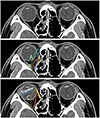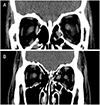Abstract
Purpose
To report the clinical manifestations and computed tomography (CT) findings of patients with a trapdoor type medial orbital wall blowout fracture.
Methods
From March 2009 to October 2016, the clinical records and computed tomography findings of patients who underwent surgical treatment for a trapdoor type medial orbital wall blowout fracture were retrospectively analyzed.
Results
A total of eight patients (six males and two females) were enrolled with a combined mean age of 14.4 years. Clinical manifestations were eyeball movement limitation (abduction and adduction) and ocular motility pain (eight patients, 100%), diplopia (seven patients, 87.5%), and nausea and vomiting (four patients, 50%). On CT, the distance from the orbital apex to the fracture site was an average of 22.0 mm and occurred in the middle position of the entire wall. Two patients had missed rectus completely dislocated into the ethmoid sinus through the fracture gap and six patients had definite involvement in the fracture gap and edema of the medial rectus muscle. The medial rectus muscle cross-sectional area was 47.7 mm2 which was edematous compared to the contralateral eye (40.1 mm2). Orbital wall reconstruction was performed an average of 4.1 days after the injury. In all patients with oculocardiac reflex-like nausea and vomiting immediately improved after surgery. Six out of eight patients who had eyeball movement limitations (abduction and adduction) preoperatively showed adduction limitation after surgery. The eyeball movement limitation and diplopia disappeared 11.7 days and 46.7 days after surgery, respectively.
Conclusions
Patients with trapdoor type medial wall blowout fracture showed characteristic computed tomographic findings and clinical manifestations such as eyeball movement limitation, ocular motility pain, diplopia, and oculocardiac reflex. An understanding of clinical findings and quick surgical treatment are therefore required. The type of eyeball movement limitation was abduction and adduction limitation preoperatively and adduction limitation postoperatively.
Figures and Tables
 | Figure 1Preoperative computed tomography findings on axial view and measurements. ‘A’ means full length of medial orbital wall, ‘B’ means length from orbital apex to the center of medial wall fracture. ‘C’ indicated virtual full length of medial rectus muscle, and ‘D’ indicated length from the equator to trapped medial rectus muscle. ‘B/A’ shows ratio for comparing fracture site, ‘C/D’ shows ratio for comparing site of trapped muscle. |
 | Figure 2Computed tomography findings of left trap-door type medial blowout fracture patient. (A) True missing rectus. (B) Definite trap-door type. |
 | Figure 3Schematic configuration of the fracture size on the coronal view of computed tomography. ‘A’ means diagonal length (arrow) at the location of the largest fracture cut, ‘B’ means diagonal width by counting the number of fracture cuts. For example, if the interval between each cut were 2 mm and the number of fracture cuts were 8, the diagonal width would be 14 mm (2 mm × [8-1]). |
 | Figure 4Eleven-year-old male patient with left trap-door type medial blowout fracture. (A) A left eyeball movement had limitations on adduction with grade 3 (arrow) and abduction with grade 2 after trauma. (B) An adduction limitation on left eye was still observed (arrow) but abduction limitation was not shown after emergency operation. (C) On postoperative day 19, left eyeball movement was nearly full on both directions. (D) Computed tomography findings after trauma showed ‘true missing rectus’ on his left eye (arrow). (E) Computed tomography after emergency operation showed well-restored medial rectus muscle. |
References
1. Su Y, Shen Q, Lin M, Fan X. Predictive factors for residual diplopia after surgical repair in pediatric patients with orbital blowout fracture. J Craniomaxillofac Surg. 2016; 44:1463–1468.


2. Park MS, Baek S. Measurement of fracture size using the picture archiving communication system in an outpatient clinic for factors that influence postoperative enophthalmos in adult inferior orbital wall fractures. J Craniofac Surg. 2013; 24:1692–1694.


3. Sorenson EJ, Gilmore JE. Cardiac arrest during strabismus surgery; a preliminary report. Am J Ophthalmol. 1956; 41:748–752.

4. Moonie GT, Rees DL, Elton D. The oculocardiac reflex during strabismus surgery. Can Anaesth Soc J. 1964; 11:621–632.

5. Aletaha M, Bagheri A, Roodneshin F, et al. Oculocardiac reflex during strabismus surgery: experience from a tertiary hospital. Strabismus. 2016; 24:74–78.


6. Kim HK, Yoon KC, Park YG. Oculocardiac reflex during strabismus surgery. J Korean Ophthalmol Soc. 2003; 44:896–903.
7. Ha SG, Huh J, Lee BR, Kim SH. Surgical factors affecting oculocardiac reflex during strabismus surgery. BMC Ophthalmol. 2018; 18:103.

8. Yano H, Minagawa T, Masuda K, Hirano A. Urgent rescue of ‘missing rectus’ in blowout fracture. J Plast Reconstr Aesthet Surg. 2009; 62:e301–e304.

9. Lee HR, Jung GY, Lee DL, Shin HK. Pediatric orbital medial wall trapdoor fracture with normal computed tomography findings. Arch Craniofac Surg. 2017; 18:128–131.

10. Kakizaki H, Zako M, Katori N, Iwaki M. Adult medial orbital wall trapdoor fracture with missing medial rectus muscle. Orbit. 2006; 25:61–63.


11. Noh WJ, Park TJ, Kim JY, Kwon JH. Isolated trapdoor-type medial blowout fracture in an adult presenting horizontal diplopia treated by endoscopic endonasal approach. J Surg Case Rep. 2013; 2013:rjt009. Accessed February 11 2013. https://academic.oup.com/jscr/article/2013/3/rjt009/2282478.

12. Tse R, Allen L, Matic D. The white-eyed medial blowout fracture. Plast Reconstr Surg. 2007; 119:277–286.


13. Davidson TM, Olesen RM, Nahum AM. Medial orbital wall fracture with rectus entrapment. Arch Otolaryngol. 1975; 101:33–35.


14. Jordan DR, Allen LH, White J, et al. Intervention within days for some orbital floor fractures: the white-eyed blowout. Ophthalmic Plast Reconstr Surg. 1998; 14:379–390.

15. Kang HJ, Ha MS. A clinical feature of the patients of orbital wall fracture with diplopia. J Korean Ophthalmol Soc. 2009; 50:969–975.

16. Nguyen DC, Shahzad F, Snyder-Warwick A, et al. Transcaruncular approach for treatment of medial wall and large orbital blowout fractures. Craniomaxillofac Trauma Reconstr. 2016; 9:46–54.


17. Kim HE, Lew H, Yun YS. The size of extraocular muscles estimated by computed tomography in patients undergoing orbital wall fracture repair. J Korean Ophthalmol Soc. 2009; 50:1447–1454.

18. Sires BS, Stanley RB Jr, Levine LM. Oculocardiac reflex caused by orbital floor trapdoor fracture: an indication for urgent repair. Arch Ophthal. 1998; 116:955–956.

19. Kosaka M, Sakamoto T, Yamamichi K, Yamashiro Y. Different onset pattern of oculocardiac reflex in pediatric medial wall blowout fractures. J Craniofac Surg. 2014; 25:247–252.


21. Kirsch RE, Samet P, Kugel V, Axelrod S. Electrocardiographic changes during ocular surgery and their prevention by retrobulbar injection. AMA Arch Ophthalmol. 1957; 58:348–356.


22. Hertle RW, Granet DB, Zylan S. The intraoperative oculocardiac reflex as a predictor of postoperative vaso-vagal responses during adjustable suture surgery. J Pediatr Ophthalmol Strabismus. 1993; 30:306–311.






 PDF
PDF ePub
ePub Citation
Citation Print
Print






 XML Download
XML Download